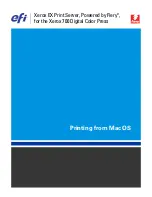
a) Cassette A feed/cassette B feed
The paper feed command sent from cassette A or B activates, normal rotation of the
feed roller motor. The spur unit and the pressure roller unit are released to prevent
the paper from coming off the paper path route.
The roll media loaded on cassette A (or cassette B) is carried by the cassette A pick
up roller (or cassette B pick up roller), the roll media feed roller, and the feed roller.
When the eject sensor detects the front end of the paper, the spur unit is activated
to carry the paper forward to the specified degree, and the paper stays at that
position.
To align the front end of the sheet while taking up the slack, the feed roller motor
spins in the opposite direction to backwind the predefined amount of paper after its
front end disappears from the detection range of the eject sensor. Then with the
paper halted, the pressure roller is activated and the detection process for the paper
width starts. The paper width is determined by the print position sensors that
identify the left and right ends of the paper.
After the paper is carried forward by the distance equivalent to its front margin,
printing starts. During the printing process, paper feeding is performed by
controlling the rotation of the paper feed rollers based on the current printing mode.
b) Manual feed
With the manual feed option selected, when you load cut sheets into the manual
feed slot, the spur unit and the pressure roller unit are deactivated to prevent the
paper from coming off the paper path route.
Cut sheets put in the manual feed slot are carried by the manual pick up roller and
the feed roller. After the front end of the paper reaches the feed roller, the paper is
carried forward the specified distance, and then the paper feeding operation stops.
To eliminate a possible skewing of the paper placement, only the feed roller rotate in
the opposite direction to carry back the paper toward the manual pick up roller.
This action produces the "warps" in the sheet. When the front end of the sheet is
released from the contact area of the feed roller, then the paper end "bumps into" the
contact area of the feed roller, aligning parallel to the feed roller. The paper is carried
forward in the square/upright orientation. When the eject sensor detects the front
end of the paper, the spur unit is activated to carry the paper forward to the
specified degree, and the paper stays at that position.
Again, to align the front end of the sheet while taking up the slack, the feed roller
motor spins in the opposite direction to backwind the predefined amount of paper
after its front end disappears from the detection range of the eject sensor. Then with
the paper halted, the pressure roller is activated and the detection process of the
paper width starts. The paper width is determined by the print position sensors that
identify the left and right ends of the paper.
After the paper is carried forward by the distance equivalent to its front margin,
printing starts. During the printing process, the paper feeding is performed by
controlling the rotation of the paper feed rollers based on the current printing mode.
Part 4: Technical Reference
4-38
BJ-W9000
Summary of Contents for BJ-W9000
Page 2: ...0201 GR 0 35 0 ...
Page 3: ......
Page 20: ...This page is intentionaly left blank ...
Page 131: ...3 81 BJ W9000 Part 3 Operations This page intentionally left blank ...
Page 143: ...4 5 BJ W9000 Part 4 Technical Reference This page intentionally left blank ...
Page 199: ...4 61 Part 4 Technical Reference BJ W9000 This page intentionally left blank ...
Page 251: ...5 31 BJ W9000 Part 5 Maintenance This page intentionally left blank ...
Page 359: ...5 139 BJ W9000 Part 5 Maintenance This page intentionally left blank ...
Page 420: ...SERVICE MANUAL ...
Page 440: ...Page 4 1 1 OPERATION OVERVIEW OVER Part 4 OPERATION VIEW ...
Page 452: ...Page A 1 1 CIRCUIT DIAGRAM A 2 2 LOCATION OF ELECTRICAL COMPONENT ON THE PCB Part 6 APPENDIX ...
Page 455: ...This document is printed on 100 recycled paper PRINTED IN JAPAN IMPRIME AU JAPON CANON INC ...
















































